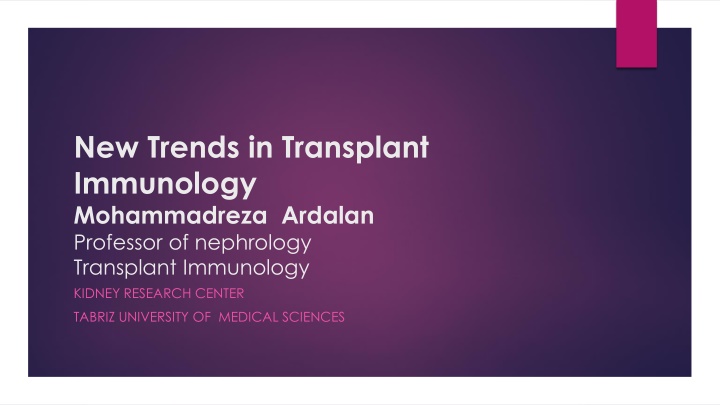
Emerging Trends in Transplant Immunology and Tolerance Strategies
Explore the latest trends in transplant immunology, including immunosuppression approaches, avoidance of C max, and tolerance strategies such as chimerism induction and maintenance immunotherapy withdrawal. Discover insights on non-chimeric HLA-identical renal transplant tolerance and operational tolerance in kidney transplantation. Stay updated on advancements in achieving immunological tolerance in transplant recipients.
Download Presentation

Please find below an Image/Link to download the presentation.
The content on the website is provided AS IS for your information and personal use only. It may not be sold, licensed, or shared on other websites without obtaining consent from the author. If you encounter any issues during the download, it is possible that the publisher has removed the file from their server.
You are allowed to download the files provided on this website for personal or commercial use, subject to the condition that they are used lawfully. All files are the property of their respective owners.
The content on the website is provided AS IS for your information and personal use only. It may not be sold, licensed, or shared on other websites without obtaining consent from the author.
E N D
Presentation Transcript
New Trends in Transplant Immunology Mohammadreza Ardalan Professor of nephrology Transplant Immunology KIDNEY RESEARCH CENTER TABRIZ UNIVERSITY OF MEDICAL SCIENCES
Trends in immunosuppression Almost 75% received T cell depleting agent induction in 2016,whereas human IgG anti (IL-2Ra) were used in approximately 20% (TAC)/ mycophenolate maintenance therapy was used in over 95% of recipients. (mTORi) use continued to decline (1.9% use at transplantation and 4.3% at 1 year after Maintenance corticosteroid use has increased from 63.8% to 71.8% at 1yeay after TX
Trends toward avoidance of C max To achieve consistent TAC exposure ER-Tac concentration (Cmax), time to peak concentration (Tmax), or trough (C0) fluctuation, whereas significantly fluctuation, and prolonged Tmax were found for LCPT (Envarsus), versus IR- Tac or ER-Tac(Astagraf) showed no differences versus IR-Tac in exposure, peak higher exposure, lower intraday CYP3A5*1 expresser (rapid metabolizers ofTAC) versus non expressors affect the out come with IR-Tac
Tolerance Tolerance strategies are based on induction immunotherapy, Transfer of donor cells to induce chimerism Withdrawal of maintenance immunotherapy. Clinical trials utilizing these approaches demonstrate that tolerance induction does not work in all patients. Spontaneous operational tolerance after kidney transplantation is associated with changes in B cell, function, T follicular helper cell subsets, and gene expression profiles
Non-Chimeric HLA-Identical Renal Transplant Tolerance 1.two intravenous doses of 0.3 mg/kg of alemtuzumab 2.early TAC maintenance at 8 10 ng/ml 3.(MPA) twice daily 4. The first DHSC infusion consisted of donor iliac crest marrow purified CD34+ cells given on day +5 at 0.3 1.0 x 106 cells/kg recipient body weight. Later it collets from peripheral blood at 3,6,9 months. 5.At 3 months, TAC was replaced by SRL (trough levels of 6 10 ng/ml) Latter it discontinued(2yr) Am J Transplant. 2016 January ; 16(1): 221 234
Twelve months later operational tolerance was confirmed by rejection-free transplant biopsies. Five of the first 8 enrollees were initially tolerant one year off immunosuppression. Biopsies of 3 others after total withdrawal showed Banff 1A acute cellular rejection without renal dysfunction. With longer follow-up including 5 year post-transplant biopsies 4 of the 5 tolerant recipients remain without rejection while one developed Banff 1A without renal dysfunction
In tolerant recepients time-dependent increases of circulating CD4+CD25+++CD127 FOXP3+ Tregs vs. losses of Tregs in non-tolerant subjects (p< 0.001). Gene expression signatures, developed using global RNA expression profiling of sequential whole blood and protocol biopsy samples, were highly associative with operational tolerance as early as 1 year post-transplant.
